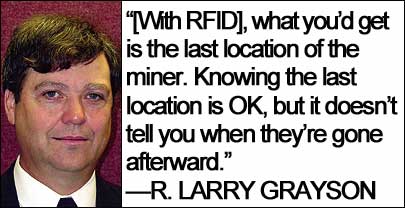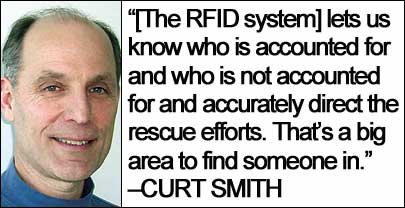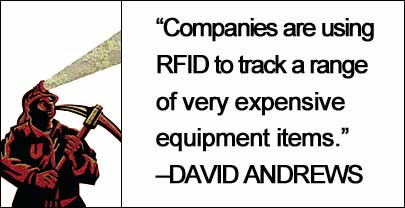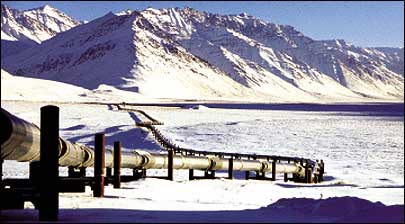Apr 01, 2006Each night at midnight, the Luossavaara-Kiirunavaara Aktiebolag (LKAB) mine in Malmberget, Sweden, one of the largest iron ore exporters in the European Union, starts setting off explosives so that workers can mine new areas in the morning. Until recently, the location of mine workers was tracked manually, so managers would know if all workers were evacuated before blasting began.
Each miner was required to move a tag with his name on it from one side of a board posted at the mine entrance to the other. But LKAB found the system unreliable, because workers kept forgetting to add or remove their names when they entered or exited the mine.
Two years ago, LKAB started testing an RFID access control system from Wtek, a Norwegian technology company. Miners were given an active (battery-powered) RFID tag to wear in a jacket pocket. RFID interrogators were set up at the mine entrance to allow the reading of 20 to 30 tags at a time as busloads of workers changed shifts.
To let managers know where workers were in the event of an emergency, eight interrogators were stationed throughout the mine, dividing the various levels of the mine, which is 3,280 feet (1,000 meters) deep, into different zones. The pilot was so successful in providing LKAB managers with a real-time accounting of workers that it was fully deployed.
Sweden is among several countries, including Austria and Norway, that have raised safety standards to protect workers in the hazardous mining industry. As a result, a growing number of mining companies in Europe, Africa, Asia and Australia are using RFID to track miners and ensure they carry safety equipment. Most mining companies in the United States are still tracking workers by means of manual systems, either time clocks or tag systems similar to the one LKAB used before deploying RFID.
Worker safety also is an issue in oil and gas production, and energy companies are looking to use RFID to comply with government regulations. But the energy industry, which has a history of deploying information technology to streamline processes, is focused on using RFID to track expensive machinery and hazardous substances, reduce maintenance costs and improve efficiency in production of petroleum products and natural gas. The mining industry is exploring the use of RFID to track assets and improve efficiency but at a slower pace, in part because mines operate with a much lower margin and have to find more justification for the expense of RFID.
In addition to ensuring that no miners are underground before explosives are set off, RFID access control systems can enable companies to quickly track employees in the event of an emergency. When a fire broke out on July 4, 2005, in the Svea Nord mine on Spitsbergen, an island 600 miles from the North Pole, managers used an RFID access control system to determine in real time how many miners had made it to safety and who was trapped underground. Just a year before the accident, the mine's owner, Store Norske Kulkompani of Norway, had installed the system made by Wtek, to meet obligations under a Norwegian occupational health and safety law.
But it is unlikely that current RFID technology can be used to prevent accidents or resulting deaths, says R. Larry Grayson, professor of mining engineering at the University of Missouri-Rolla. One miner died in the Svea Nord fire. The 12 miners who died in January after an explosion inside West Virginia's Sago Mine had barricaded themselves in an area to await rescue, but they ran out of oxygen before help arrived.
"What you'd get is the last location of the miner," says Grayson. "Knowing the last location is OK, but it doesn't tell you where they've gone afterward."
The tragic deaths of four more West Virginian miners following the Sago Mine disaster prompted the state legislature to quickly pass a law mandating electronic tracking of employees in underground mines. And the U.S. Department of Labor's Mine Safety and Health Administration has asked for information from individuals, researchers and companies relevant to underground mine rescue equipment and technology in a move that could lead to tougher new mining regulations.
Grayson, who once worked in a mine in Pennsylvania, is chairing a new National Mining Association commission that will look at how technologies—most prominently RFID—might help improve mine safety. He believes that a combination of the electronic tracking of miners, greater supplies of oxygen kept underground and the creation of "safe rooms," where trapped miners could retreat to, might be able to speed rescues and prevent some mining deaths. But, he adds, the jury is out on whether RFID interrogators can be hardened to survive a fire or explosion to continue tracking workers after an accident.
BP, one of the world's largest energy companies, with oil and gas exploration operations in 26 different countries and 21 refineries worldwide, is currently deploying an ultra-wideband active RFID system to track up to 3,000 workers at a refinery in Washington State. After a successful pilot last August, BP expects to fully deploy the program by the fall. Workers will be issued ID badges with a battery-operated RFID tag. The tag will be read when a worker enters any of the eight gates leading to the 2,000-acre facility. The 64-acre processing areas will be densely covered with interrogators to provide up to 1-meter accuracy and account for personnel in the event of an emergency.
"This lets us know who is accounted for and who is not accounted for and accurately direct the rescue efforts," says Curt Smith, BP's applications director in the chief technology office, who is overseeing the RFID deployment. "That's a big area to find someone in." Smith says that the company hopes to expand the worker-tracking program to other refineries.
Tracking and Maintaining Assets
In BP's Alaskan oil fields, RFID is keeping workers out of harm's way by allowing the company to maintain pipes with sensor networks. BP also is using RFID to keep track of assets—gas pumps, car wash machinery, refrigeration units and other equipment—in 1,200 gas stations in South Africa. The system has the added benefit of helping workers identify parts for use in maintenance.
Chris Hook, service line leader at Deloitte Consulting, says his company is working with several firms in the energy industry on RFID and sensor applications. Companies need to track containers of bulk chemicals used in processing oil and other petroleum products from one facility to the next. They also need to track the disposal of waste. RFID would automate the process.
U.S. energy companies are required by law to keep track of any hazardous materials used in processing energy supplies. This has led some companies to experiment with RFID and sensors to track some of these materials at facilities and during transport. "They need to track them for safety and security, both from the liability perspective and also from federal requirements," says David Andrews, senior executive in the North American chemicals practice for Accenture. "They need to know exactly where they are and what's happening."
The mining industry is using RFID to track equipment in mines that can stretch on for miles and include hundreds of shafts off the main tunnels. Drills, trucks and other expensive equipment are needed in different locations in the mine at different times, depending on whether miners are blasting new areas or drilling or extracting ore or other materials. The equipment is usually tracked manually underground and that process is not always accurate. Production can be slowed if workers have to try to locate the equipment they need before proceeding.
Inco, of Toronto, one of the world's leading nickel companies, has started using an RFID solution from AeroScout, of San Mateo, Calif., to track vehicles, containers and drills in its mine in Sudbury, Ontario. The company has a 200-vehicle underground fleet, including jeeps, utility trucks and load-haul-dumps (the latter are valued at nearly $1 million each). The vehicles will be fitted with active RFID tags, and their whereabouts in the mine will be tracked by wireless access points that are already set up throughout the mine to provide voice communications. When Inco officials need trucks to work a certain area of the mine, they can use the tracking system to easily locate where the trucks are.
By tracking equipment underground, Inco believes it will be better able to track the amount of ore the company is mining. This process is currently done by operators, who record on paper how many buckets of ore from each location in the mine were left at certain dumping points. They then hand the paper off to someone else who inputs the data into a computer. "It is imprecise and slow," says Peter Cunningham, Inco's senior technology specialist. "We want to get accurate data."
More accurate data gained through RFID tracking will also help Inco better plan which areas to mine. When tonnage goes down, the company knows it is getting into rock instead of ore and can move on to mine different locations.
Other mines use asset tracking for a dual purpose: to keep tabs on expensive equipment and to make sure workers are equipped with safety devices. In 2005, Anglo American, the world's second-largest mining company, rolled out an RFID system from iPico Holdings, based in Pretoria, South Africa, to track and manage the lamp batteries and emergency packs of workers in several South African mines. In many parts of the world, safety regulations require the packs to be attached to the belts worn by miners. Mining companies are liable for damages if miners die or are injured in accidents and failed to have the emergency equipment with them. "This provides the efficiency of having an inventory control system, knowing those battery packs have been charged and how long they have been out there," says Luther Erasmus, CEO of iPico.
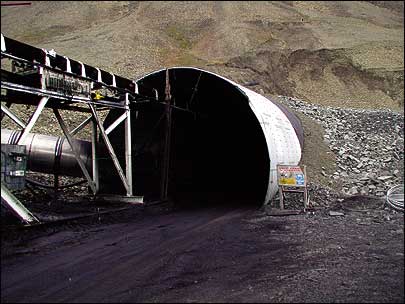
Ripe for Adoption
The mining and energy industries face major challenges in deploying RFID in harsh environments and potentially highly explosive atmospheres. RFID equipment has to be intrinsically certified or housed in intrinsically safe containers, to avoid the production of sparks or other forms of energy that could ignite flammable material.
Both industries also operate in environments surrounded by water and metals, matter that is not RF friendly, and workers use metal containers and equipment. Some technology companies are already trying to address these problems. IPico last year unveiled a dual-frequency RFID system that combines low- and high-frequency RFID, to maximize read rates through materials that have water, iron or carbon content. IPico says its dual-frequency technology can also read 120 tags simultaneously at ranges from 30 centimeters (12 inches) to 3 meters (10 feet).
Enertag, a Paris-based RFID solutions company, is in discussions with oil companies in the United Arab Emirates and Mexico about using its patented underwater RFID interrogators and tags for pipeline maintenance and security. Jean Yves Satre, Enertag's chief executive officer, says his company has developed a passive RFID tag that can be placed at certain intervals along an underwater oil pipeline to help companies pinpoint breaches or other trouble spots. The tags work in combination with the less-reliable robots that companies have traditionally deployed inside the pipeline. The tags are read by underwater divers with either handheld interrogators or interrogators attached to cables that are dropped from a vessel. The company is working to develop an active RFID tag that would act as an underwater pipeline marker.
"A system like that [RFID]," says Grayson, the mining professor who is chairing the National Mining Association commission, "if you want a well-run, safe and productive mine, will pay for itself very quickly."
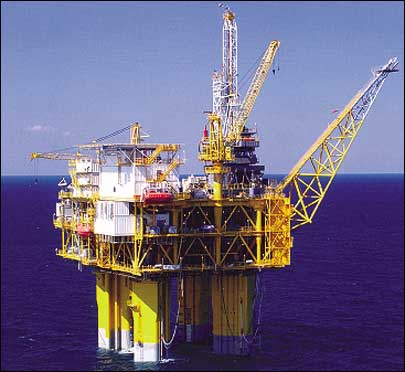
Sensor Networks Help Protect Workers and the Environment
Until last fall, BP, one of the world's largest energy companies, sent employees on weekly drives to download data manually from 80 different corrosion measurement points along a 24-inch-wide pipeline that runs through the Prudhoe Bay oil field in Alaska and funnels oil to BP's central gathering points.
"What we had to do is physically drive out to those locations and, in the winter, that could be problematic," says Dave Lafferty, a consultant with BP's chief technology office for digital technology. "It's dangerous, labor-intensive and we don't like to put our people in those types of dangerous environments."
Now under a test project, a network of motes—self-powered wireless sensors—automatically collects and downloads the information about corrosion rates in the pipeline and transmits it to BP in real time. Such sensor networks are proving valuable in the energy industry, particularly in remote or harsh environments, where wells are often drilled. Conventional radios require line of sight to download data, but sensor networks allow a large number of battery-operated motes to communicate with each other and form ad hoc networks until the data reaches the final destination.
Sensor networks also are providing more up-to-date information to BP officials about the state of corrosion in pipelines. In addition to oil and gas, the pipelines sometimes carry water, which can corrode the interior of the metal pipes. Corrosion can lead to environmentally damaging pipeline spills and costly pipeline replacement.
To counteract the effects of water in the pipeline, BP adds a certain mix of chemicals that fight corrosion. The sensor networks let BP know in real time how much of that chemical to add to oil and gas being moved in the pipeline. The pilot is being tested in a 50-square-mile area of Prudhoe Bay, the largest oil field in the United States, and will eventually be extended to a 400-square-mile area.
At BP's Cushing, Okla., terminal complex, a field trial tested a sensor network system designed to protect underground pipes from damage by inadvertent encroachment on BP rights-of-way by construction crews building new roads or subdivisions. The motes were set up on traffic cones along a simulated pipeline and alerted BP to unauthorized activity crossing into the detection zone.
The objective was not only to avoid damage to the pipelines but also to prevent environmental damage from oil spills. BP has deemed the pilot a success and is now working with manufacturers to develop commercial products that can make such portable mesh networks more widely available.
Illustration by Tivadar Boté.


